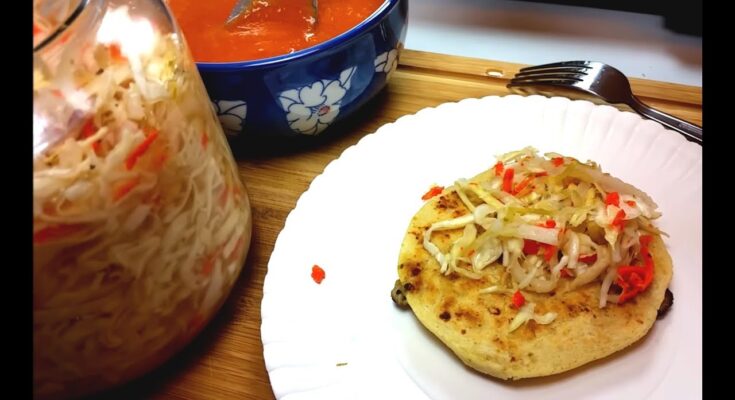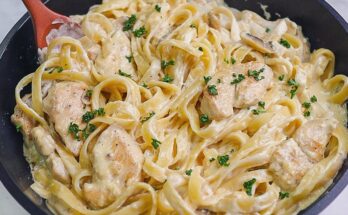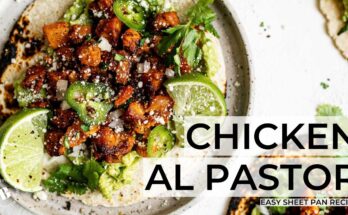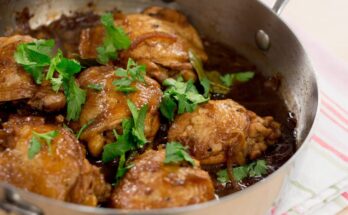Pupusas Recipe: Pupusas are a traditional Salvadoran dish made of thick corn tortillas stuffed with a variety of fillings like cheese, pork, or beans. They’re flavorful, hearty, and versatile, making them a favorite comfort food for many around the world. Think of them as pockets of joy—every bite is packed with savory goodness.
The Origin of Pupusas
Pupusas originated in El Salvador centuries ago, with evidence of their existence dating back to pre-Columbian times. The indigenous Pipil people are credited with inventing them, using maize as a staple ingredient. Over time, pupusas became a cultural symbol of El Salvador, eventually gaining international recognition.
Why Pupusas Are So Popular
Their popularity lies in their simplicity and flavor. Pupusas are affordable, easy to customize, and pair wonderfully with traditional accompaniments like curtido (a pickled cabbage slaw) and salsa roja. Plus, they’re perfect for any meal—breakfast, lunch, or dinner.
Ingredients Needed for Pupusas
Essential Ingredients for the Dough
- 2 cups masa harina (corn flour)
- 1 ½ cups warm water
- Pinch of salt
These basic ingredients form the foundation of the pupusa dough, creating a pliable, slightly moist consistency.
Classic Fillings for Pupusas
- Cheese: Quesillo or mozzarella work well for the gooey, cheesy center.
- Pork (Chicharrón): Cooked and finely ground pork seasoned with spices.
- Refried Beans: Creamy and well-seasoned black or pinto beans.
Optional Ingredients to Enhance Flavor
- Diced jalapeños for a spicy kick
- Spinach or squash for a healthier twist
- Cooked shrimp or chicken for added protein
Tools You’ll Need
Basic Tools for Making Pupusas
- Large mixing bowl for dough preparation
- Spatula or wooden spoon for mixing
- Plastic wrap or parchment paper to shape the pupusas
Recommended Add-Ons for Easier Preparation
- A tortilla press (if you’re aiming for perfectly round pupusas)
- Non-stick griddle or cast-iron skillet for cooking
- Food processor for preparing chicharrón filling
How to Make Pupusa Dough
Preparing the Masa Harina
- In a large mixing bowl, combine 2 cups of masa harina with a pinch of salt.
- Gradually add 1 ½ cups of warm water while mixing with your hands or a spatula.
- Continue kneading until the dough is smooth, pliable, and not sticky. If it feels too dry, add a bit more water, one tablespoon at a time.
Achieving the Perfect Dough Texture
The key to perfect pupusa dough is its consistency. It should be moist but not wet, soft enough to shape but firm enough to hold the filling. Cover the dough with a damp cloth to prevent it from drying out as you work.
Preparing the Fillings
How to Make the Cheese Filling
- Grate 1 ½ cups of quesillo or mozzarella cheese.
- If desired, mix in diced jalapeños for extra flavor.
- Set aside in a bowl until ready to assemble.
Preparing Pork (Chicharrón) Filling
- Sauté 1 pound of pork in a skillet until fully cooked, then let it cool.
- Blend the pork in a food processor with garlic, onion, and a pinch of salt until it becomes a smooth paste.
- Add a splash of tomato sauce for a touch of moisture and flavor.
Vegetarian-Friendly Filling Options
For a meat-free option, sauté diced vegetables like zucchini, spinach, or mushrooms. Combine with cheese for a flavorful filling.
Assembling the Pupusas
Shaping the Dough
- Divide the prepared dough into small, golf-ball-sized portions. Each ball should weigh about 2-3 ounces.
- Roll each piece between your palms to form a smooth ball.
- Flatten the dough ball into a disc about 4 inches in diameter. Use your fingers or a tortilla press (lined with plastic wrap) to ensure an even shape.
Adding the Fillings
- Place about 1-2 tablespoons of your chosen filling (cheese, beans, or chicharrón) in the center of the disc. Avoid overfilling to prevent leaks.
- Carefully fold the edges of the dough up and over the filling, enclosing it completely.
Sealing Techniques to Avoid Leaks
- Pinch the dough edges together to seal, ensuring the filling stays inside.
- Flatten the sealed ball gently with your palms, creating a thick, flat disc about 4-5 inches in diameter.
Repeat these steps for the remaining dough and fillings. Keep finished pupusas covered with a damp cloth to prevent drying.
Cooking the Pupusas
How to Cook Pupusas on a Griddle
- Preheat a non-stick griddle, cast-iron skillet, or large frying pan over medium heat.
- Place the pupusas on the hot surface, cooking for 3-4 minutes on each side.
- Turn them carefully with a spatula to ensure even cooking and a golden-brown exterior.
Tips for Achieving a Crispy, Golden Exterior
- Avoid overcrowding the pan to allow even heat distribution.
- Use medium heat; cooking on high can cause the exterior to burn before the inside is cooked through.
- Lightly oil the pan if needed, but traditionally, pupusas are cooked without added oil.
Alternative Cooking Methods (Oven or Grill)
- Oven: Preheat to 375°F (190°C). Place pupusas on a baking sheet lined with parchment paper and bake for 15-20 minutes, flipping halfway through.
- Grill: Use a medium heat setting and cook pupusas directly on the grill, flipping every 2-3 minutes until fully cooked.
Making the Traditional Curtido
Ingredients for Curtido
- 2 cups shredded green cabbage
- 1 large carrot, grated
- ½ small red onion, thinly sliced
- 1 cup white vinegar
- 1 cup hot water
- 1 teaspoon dried oregano
- 1 teaspoon salt
Step-by-Step Curtido Preparation
- In a large mixing bowl, combine the shredded cabbage, grated carrot, and sliced onion.
- Sprinkle the mixture with oregano and salt, tossing to distribute evenly.
- In a separate bowl, mix white vinegar and hot water. Pour the mixture over the vegetables.
- Stir well, cover, and let it sit at room temperature for at least 2 hours. For best results, refrigerate overnight to enhance the flavors.
Serving Suggestions
Traditional Pupusas Presentation
Serve freshly cooked pupusas on a large plate with a generous side of curtido and a bowl of salsa roja. For an authentic Salvadoran experience, eat them with your hands—no forks required!
Pairing Pupusas with Curtido and Salsa Roja
- Curtido’s tangy crunch complements the soft, savory pupusas.
- Salsa roja, made with blended tomatoes, garlic, and spices, adds a burst of flavor.
- To spice things up, add a drizzle of hot sauce or serve with pickled jalapeños.
Tips for Perfect Pupusas
Common Mistakes to Avoid
- Overfilling: Too much filling makes the pupusas prone to leaking. Stick to 1-2 tablespoons per pupusa.
- Dry Dough: Keep the dough moist by covering it with a damp cloth while assembling.
- Uneven Cooking: Ensure your skillet or griddle is evenly heated before placing the pupusas.
How to Store and Reheat Pupusas
- Storage: Allow cooked pupusas to cool completely, then store them in an airtight container in the refrigerator for up to 3 days.
- Reheating: Heat them on a non-stick skillet over medium heat for 2-3 minutes on each side or in the microwave for 30-60 seconds.
Variations of Pupusas
Cheese and Jalapeño Pupusas
For a spicy twist, combine shredded cheese with finely diced jalapeños. This variation offers a subtle heat that pairs wonderfully with curtido.
Sweet Pupusas for Dessert
Swap savory fillings for sweet ones like dulce de leche, sweetened black beans, or Nutella. These dessert pupusas are a crowd-pleaser!
Fusion-Inspired Pupusa Flavors
Experiment with non-traditional fillings like pulled pork, barbecue chicken, or even shredded buffalo chicken for a modern take.
Nutritional Information
Calories and Macros Breakdown
A standard cheese pupusa contains approximately 150-200 calories, depending on the filling and cooking method. They are a good source of carbohydrates and protein but should be enjoyed in moderation if you’re watching your fat intake.
Adjusting for Dietary Restrictions
- For gluten-free pupusas, ensure the masa harina is certified gluten-free.
- Vegans can substitute cheese with plant-based alternatives or focus on bean and vegetable fillings.
FAQs about Pupusa Recipe
What is a pupusa?
A pupusa is a traditional Salvadoran dish made of a thick, handmade corn tortilla that is typically filled with a blend of cheese, cooked pork (chicharrón), and refried beans. It can also include other fillings like loroco (a vine flower bud native to Central America) or ayote (a type of squash).
What ingredients do I need to make pupusas?
To make pupusas, you will need masa harina (corn flour), water, salt, and fillings of your choice such as cheese, chicharrón, or refried beans. Optional ingredients may include loroco or zucchini for additional flavor.
How do I shape a pupusa?
Start by mixing masa harina with water and salt to form a dough. Take a small amount of dough, roll it into a ball, and then make a well in the center for the fillings. Add your chosen fillings, then close the dough around them and flatten it into a disc. Finally, gently pat the dough between your hands to form an even, round pupusa.
Can I make pupusas if I’m gluten-intolerant?
Yes, pupusas are naturally gluten-free as they are made from masa harina, which is a type of corn flour. However, ensure that the masa harina brand you are using does not contain any gluten contaminants.
What are the best toppings for pupusas?
Pupusas are traditionally served with curtido (a spicy cabbage slaw) and tomato salsa. The curtido provides a tangy contrast to the rich flavors of the pupusa fillings, while the salsa adds a refreshing, spicy kick.
How do I cook pupusas?
Cook pupusas on a hot griddle or skillet over medium heat. No oil is needed as the dough itself will brown and crisp up. Cook each side for about 2-4 minutes until golden brown and the cheese is melted.
Can pupusas be made in advance?
Yes, you can prepare the dough and the fillings in advance. The shaped pupusas can be refrigerated overnight or frozen for longer storage. When ready to eat, cook them directly from the fridge or freezer, adding a few extra minutes to the cooking time if frozen.
Are there any variations of the traditional pupusa recipe?
Yes, there are many variations. Some popular ones include using different types of cheeses, adding jalapeños or other vegetables for a different flavor profile, or even substituting the traditional fillings with vegan alternatives like beans and vegan cheese.
Conclusion
Pupusas are more than just a meal—they’re a window into Salvadoran culture and history. From the handmade dough to the flavorful fillings, every bite tells a story of tradition and love.
They’re easy to make, endlessly customizable, and perfect for sharing with family and friends. Whether you’re new to Salvadoran cuisine or a long-time fan, pupusas are sure to impress.



